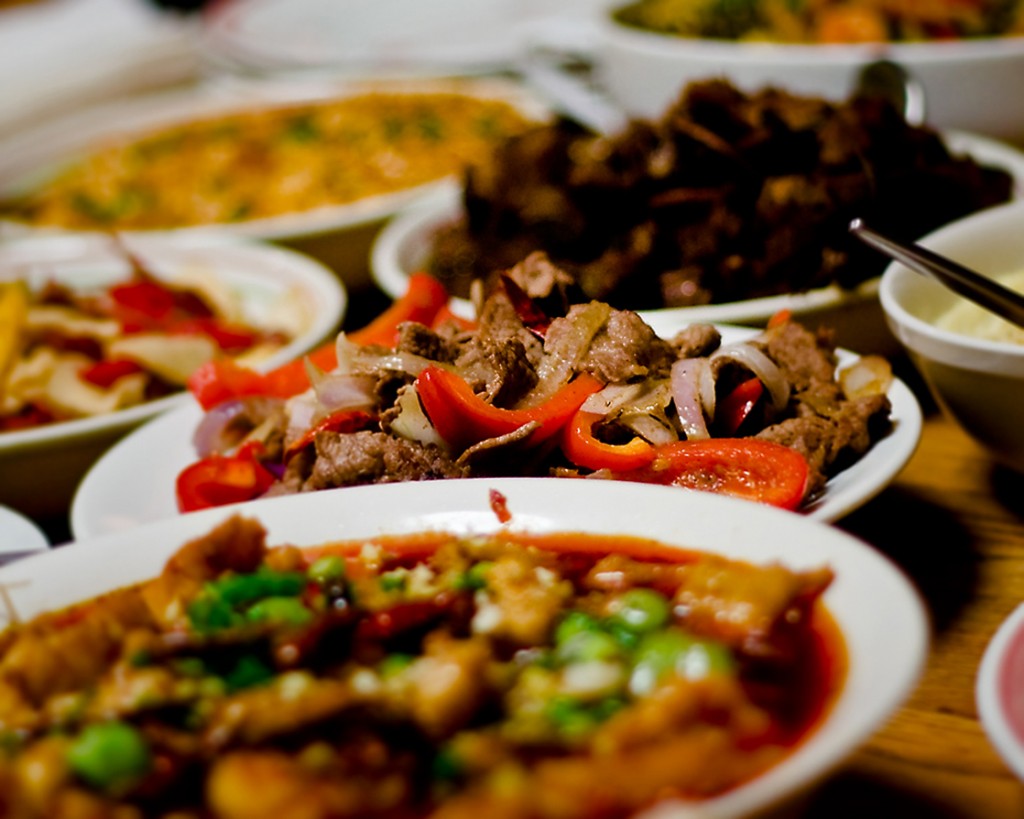60 15.4 Digestive System Regulation
Learning Objectives
By the end of this section, you will be able to:
- Discuss the role of neural regulation in digestive processes
- Explain how hormones regulate digestion
The brain is the control center for the sensation of hunger and satiety. The functions of the digestive system are regulated through neural and hormonal responses.
Neural Responses to Food
In reaction to the smell, sight, or thought of food, like that shown in Figure 15.20, the first hormonal response is that of salivation. The salivary glands secrete more saliva in response to the stimulus presented by food in preparation for digestion. Simultaneously, the stomach begins to produce hydrochloric acid to digest the food. Recall that the peristaltic movements of the esophagus and other organs of the digestive tract are under the control of the brain. The brain prepares these muscles for movement as well. When the stomach is full, the part of the brain that detects satiety signals fullness. There are three overlapping phases of gastric control—the cephalic phase, the gastric phase, and the intestinal phase—each requires many enzymes and is under neural control as well.

Seeing a plate of food triggers the secretion of saliva in the mouth and the production of HCL in the stomach. (credit: Kelly Bailey)
Digestive Phases
The response to food begins even before food enters the mouth. The first phase of ingestion, called the cephalic phas, is controlled by the neural response to the stimulus provided by food. All aspects—such as sight, sense, and smell—trigger the neural responses resulting in salivation and secretion of gastric juices. The gastric and salivary secretion in the cephalic phase can also take place due to the thought of food. Right now, if you think about a piece of chocolate or a crispy potato chip, the increase in salivation is a cephalic phase response to the thought. The central nervous system prepares the stomach to receive food.
The gastric phase begins once the food arrives in the stomach. It builds on the stimulation provided during the cephalic phase. Gastric acids and enzymes process the ingested materials. The gastric phase is stimulated by (1) distension of the stomach, (2) a decrease in the pH of the gastric contents, and (3) the presence of undigested material. This phase consists of local, hormonal, and neural responses. These responses stimulate secretions and powerful contractions.
The intestinal phase begins when chyme enters the small intestine triggering digestive secretions. This phase controls the rate of gastric emptying. In addition to gastrin emptying, when chyme enters the small intestine, it triggers other hormonal and neural events that coordinate the activities of the intestinal tract, pancreas, liver, and gallbladder.
Hormonal Responses to Food
The endocrine system controls the response of the various glands in the body and the release of hormones at the appropriate times.
One of the important factors under hormonal control is the stomach acid environment. During the gastric phase, the hormone gastrin is secreted by G cells in the stomach in response to the presence of proteins. Gastrin stimulates the release of stomach acid, or hydrochloric acid (HCl) which aids in the digestion of the proteins. However, when the stomach is emptied, the acidic environment need not be maintained and a hormone called somatostatin stops the release of hydrochloric acid. This is controlled by a negative feedback mechanism.
In the duodenum, digestive secretions from the liver, pancreas, and gallbladder play an important role in digesting chyme during the intestinal phase. In order to neutralize the acidic chyme, a hormone called secretin stimulates the pancreas to produce alkaline bicarbonate solution and deliver it to the duodenum. Secretin acts in tandem with another hormone called cholecystokinin (CCK). Not only does CCK stimulate the pancreas to produce the requisite pancreatic juices, it also stimulates the gallbladder to release bile into the duodenum.
Concept in Action

Visit
this website to learn more about the endocrine system. Review the text and watch the animation of how control is implemented in the endocrine system.
Another level of hormonal control occurs in response to the composition of food. Foods high in lipids take a long time to digest. A hormone called gastric inhibitory peptide is secreted by the small intestine to slow down the peristaltic movements of the intestine to allow fatty foods more time to be digested and absorbed.
Understanding the hormonal control of the digestive system is an important area of ongoing research. Scientists are exploring the role of each hormone in the digestive process and developing ways to target these hormones. Advances could lead to knowledge that may help to battle the obesity epidemic.
Summary
The brain and the endocrine system control digestive processes. The brain controls the responses of hunger and satiety. The endocrine system controls the release of hormones and enzymes required for digestion of food in the digestive tract.
Exercises
- Which of the following is a pseudo-ruminant?
- cow
- pig
- crow
- horse
- Which of the following statements is untrue?
- Roughage takes a long time to digest.
- Birds eat large quantities at one time so that they can fly long distances.
- Cows do not have upper teeth.
- In pseudo-ruminants, roughage is digested in the cecum.
- The acidic nature of chyme is neutralized by ________.
- potassium hydroxide
- sodium hydroxide
- bicarbonates
- vinegar
- The digestive juices from the liver are delivered to the ________.
- stomach
- liver
- duodenum
- colon
- Which of the following statements is not true?
- Essential nutrients can be synthesized by the body.
- Vitamins are required in small quantities for bodily function.
- Some amino acids can be synthesized by the body, while others need to be obtained from diet.
- Vitamins come in two categories: fat-soluble and water-soluble.
- Which of the following is a water-soluble vitamin?
- vitamin A
- vitamin E
- vitamin K
- vitamin C
- What is the primary fuel for the body?
- carbohydrates
- lipids
- protein
- glycogen
- Excess glucose is stored as ________.
- fat
- glucagon
- glycogen
- it is not stored in the body
- Where does the majority of protein digestion take place?
- stomach
- duodenum
- mouth
- jejunum
- Lipases are enzymes that break down ________.
- disaccharides
- lipids
- proteins
- cellulose
- Which hormone controls the release of bile from the gallbladder
- pepsin
- amylase
- CCK
- gastrin
- Which hormone stops acid secretion in the stomach?
- gastrin
- somatostatin
- gastric inhibitory peptide
- CCK
- Describe how hormones regulate digestion.
- Describe one or more scenarios where loss of hormonal regulation of digestion can lead to diseases.
Answers
- D
- B
- C
- C
- A
- D
- A
- C
- A
- B
- C
- B
- Hormones control the different digestive enzymes that are secreted in the stomach and the intestine during the process of digestion and absorption. For example, the hormone gastrin stimulates stomach acid secretion in response to food intake. The hormone somatostatin stops the release of stomach acid.
- There are many cases where loss of hormonal regulation can lead to illnesses. For example, the bilirubin produced by the breakdown of red blood cells is converted to bile by the liver. When there is malfunction of this process, there is excess bilirubin in the blood and bile levels are low. As a result, the body struggles with dealing with fatty food. This is why a patient suffering from jaundice is asked to eat a diet with almost zero fat.
Glossary
- bile
- digestive juice produced by the liver; important for digestion of lipids
- cephalic phase
- first phase of digestion, controlled by the neural response to the stimulus provided by food
- cholecystokinin
- hormone that stimulates the contraction of the gallbladder to release bile
- chyme
- mixture of partially digested food and stomach juices
- digestion
- mechanical and chemical break down of food into small organic fragments
- duodenum
- first part of the small intestine where a large part of digestion of carbohydrates and fats occurs
- endocrine system
- system that controls the response of the various glands in the body and the release of hormones at the appropriate times
- esophagus
- tubular organ that connects the mouth to the stomach
- gallbladder
- organ that stores and concentrates bile
- gastric inhibitory peptide
- hormone secreted by the small intestine in the presence of fatty acids and sugars; it also inhibits acid production and peristalsis in order to slow down the rate at which food enters the small intestine
- gastric phase
- digestive phase beginning once food enters the stomach; gastric acids and enzymes process the ingested materials
- gastrin
- hormone which stimulates hydrochloric acid secretion in the stomach
- ingestion
- act of taking in food
- intestinal phase
- third digestive phase; begins when chyme enters the small intestine triggering digestive secretions and controlling the rate of gastric emptying
- jejunum
- second part of the small intestine
- liver
- organ that produces bile for digestion and processes vitamins and lipids
- pancreas
- gland that secretes digestive juices
- pepsin
- enzyme found in the stomach whose main role is protein digestion
- peristalsis
- wave-like movements of muscle tissue
- roughage
- component of food that is low in energy and high in fiber
- ruminant
- animal with a stomach divided into four compartments
- secretin
- hormone which stimulates sodium bicarbonate secretion in the small intestine
- small intestine
- organ where digestion of protein, fats, and carbohydrates is completed
- somatostatin
- hormone released to stop acid secretion when the stomach is empty
- stomach
- saclike organ containing acidic digestive juices
- vitamin
- organic substance necessary in small amounts to sustain life

